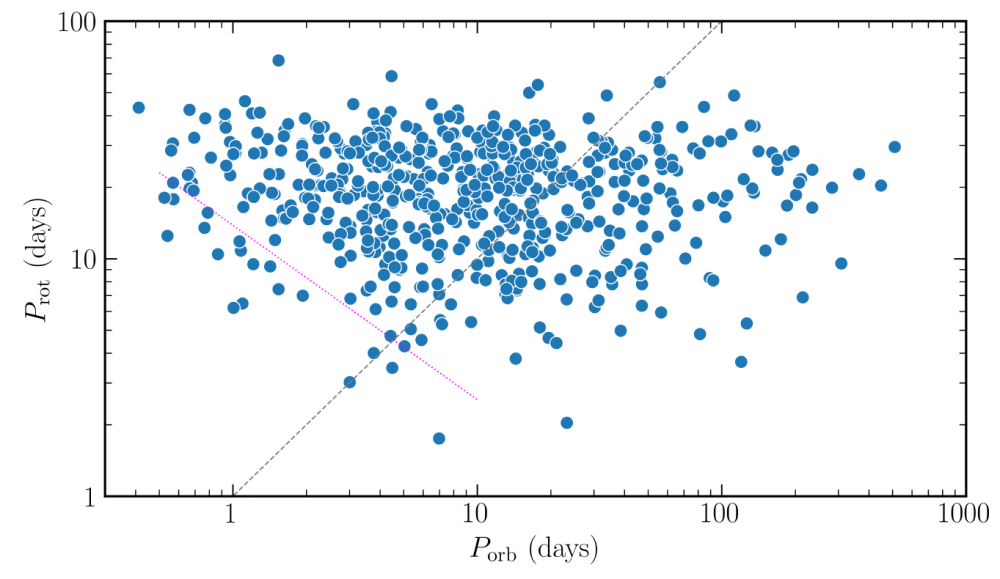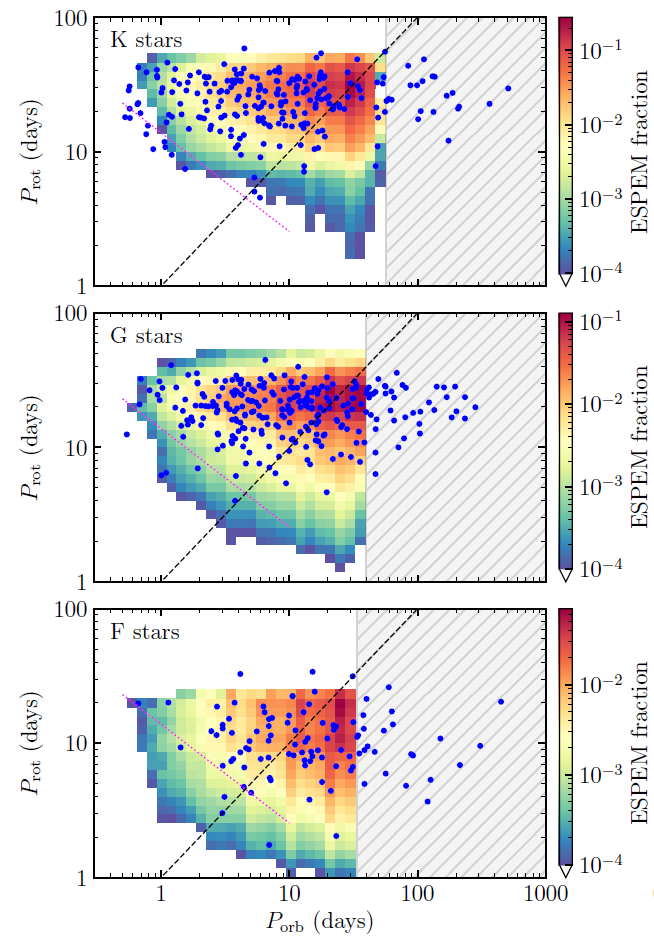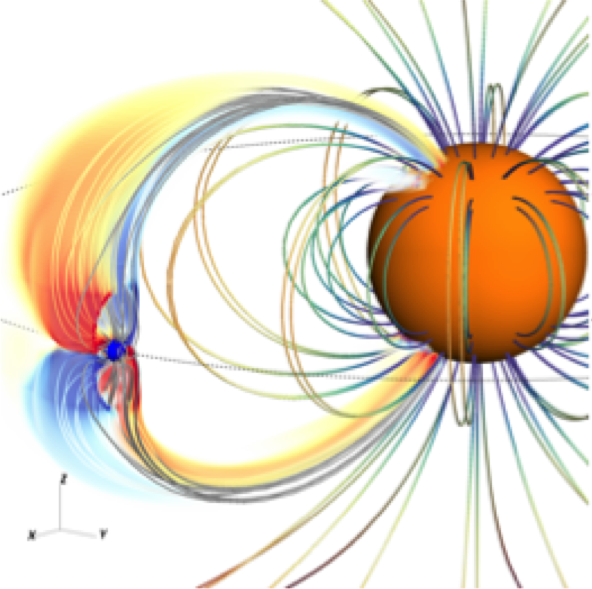To unravel this mystery, several teams with diverse skills from the Astrophysics Department had to come together, as the architecture that unites the star to its planet is highly complex. They had to combine a detailed understanding of stellar and planetary physics, exploring their interactions, with a thorough knowledge of the observations made by NASA's Kepler satellite to be able to decipher the data.
The study shows that the observed rarity seems to derive not from observational bias, but rather from physical causes. Tidal effects and magnetism are sufficient to explain qualitatively and quantitatively the migration of nearby planets around fast-rotating stars. Moreover, this migration appears to be dependent on the spectral type (fundamentally linked to mass) of the star. While these results are promising, it is nevertheless necessary to expand the sample size to better constrain scarcity and better understand the mechanisms at play. In particular, this study highlights the importance of considering the spectral type of stars (their masses) if we are to correctly model star-planet interactions.
This work is published in Astronomy & Astrophysics.
A hole in the data: observational bias or physical reality?
Launched in 2009, the Kepler satellite observed the same portion of the sky for over 4 years, searching for exoplanets using the transit method. With the discovery of over 3,000 exoplanets to its credit, contributing to more than half of all confirmed discoveries to date, Kepler has revolutionized our understanding of planets and their host stars.
Science is built on discoveries, but always with the presence of uncertainties and biases, linked to several factors, known or not. In particular, there are observational biases, which can lead to erroneous conclusions simply because the sample studied is not representative. Researchers are therefore on the lookout for them, using statistical tests in particular.
In the case of Kepler observations, from 2013 onwards (McQuillan et al. 2013), a shortage of planets was observed as they got closer to stars, but not just any stars: those that rotate rapidly on themselves, known as "fast-rotating" (i.e. up to 10 times faster than our Sun). In Figure 2, a dearth is clearly visible below the magenta line. Is this hole simply due to an observational bias, linked to too few observations for example, or is there an underlying physical reason?

Figure 2 - The diagram shows the rotation period of the star (Prot) as a function of the orbital period of the planets (Porb) detected by the Kepler satellite. The blue dots represent a system composed of a single planet and a single star. The lower the point on the diagram, the faster the host star rotates on itself. The further to the left, the faster the planet orbits its star, meaning that it is close to it. Thus, there is a shortage of planets close to fast-rotating stars (bottom left), represented by the magenta dotted line. The grey dotted line corresponds to 1:1 synchronization, i.e. the planet rotates at the same speed around its star as the star rotates on itself.
Credit : Garcia et al. 2023
Meticulously selected data
In order to understand this data paucity, the researchers will compare these observed systems with a synthetic population calculated with the ESPEM (Evolution of Planetary Systems and Magnetism) star-planet evolution code. The latter calculates the tidal and magnetic interactions in a system composed of a single star and a single planet, from the dissipation phase of the gas disk in which the exo-planetary system forms to the end of the main sequence.
Then, just as a good cook carefully selects his ingredients before concocting a dish, the researchers begin by strictly selecting the study sample so as not to introduce any observational bias that might distort the results.
To achieve this, the observational data must meet two criteria:
- Use only Kepler observations whose characteristics are very well known and mastered. Mixing data from different telescopes could introduce observational bias.
- Systems that can be modeled by the ESPEM code. Namely: Systems must contain a single planet and a single star. The star must be in the main sequence (i.e. stars that burn Hydrogen in their core), and have sufficient magnetic spots on their surface to be able to precisely measure their rotation period (Prot).
In total, 576 of the exo-planetary systems observed by Kepler meet these criteria.
A dearth confirmed by stellar models
The synthetic exo-planetary systems generated by the ESPEM model code also predict a dearth of planets in close orbits around fast-rotating stars, a prediction consistent with the Kepler data sample, as shown in Figure 3. Furthermore, a correlation seems to emerge with the spectral type of stars, in other words, with their mass: there would be more planets close to cold, low-mass, fast-rotating K-type stars (0.436 ≤ M ≤ 0.896 M?), than around hot, massive F-type stars (M >= 1.015 M?).
This trend can be explained by the complex interaction between star and planet, governed mainly by gravitational and magnetic forces.
Gravitational interaction between two celestial bodies generates tidal effects, inducing deformations in their structure. These deformations dissipate energy (initially in gravitational form) in the form of heat, resulting in an exchange of angular momentum that can slow or accelerate the rotation of the central star, causing the planet to migrate outwards or towards the star. This is why the Moon moves away from the Earth by 3.8 cm per year: terrestrial tides, mainly caused by the Moon, slow down the Earth's rotation, contributing to the Moon's movement away. Similarly, a planet can migrate due to the tidal effects it generates on its star, with more pronounced effects for more massive planets.
Secondly, magnetism, generally (but not always) of lesser intensity, comes into play. In the same way that a large ship disrupts the speed of a smaller one entering its path, the magnetic imprint of a star in its environment applies a magnetic drag to the planets in orbit. The closer the planet is to the star, the more intense this drag is, and can cause the planet to migrate on typical timescales of hundreds of millions of years.
The orbits of massive planets are mainly influenced by tides, while less massive planets are mainly affected by magnetism. For hot F-type stars, the predominant influence is magnetic, whereas for cooler stars, tides play a decisive role. Thus, depending on the spectral type of the star and the mass of the planet, a planet can migrate more or less far from its star, explaining the observed planetary distribution in orbit around fast-rotating stars.
However, while these results are promising, it is necessary to increase the sample size to better constrain scarcity and understand the mechanisms involved. Nevertheless, these preliminary conclusions the importance of considering the spectral type of stars in the future when modeling the interactions between a star and its planet.
Contacts : Rafael Garcia and Antoine Strugarek

Figure 3 - Same legend as figure 2, separated this time by the star's spectral type, with the coolest stars at the top, overlaid with the possible star-planet distribution calculated by the ESPEM code, with the highest density in red. Note that there is a factor of 100 difference between the red and green colors in the density scale. The grey area corresponds to the parameter space that cannot be calculated by ESPEM.
Credit: Garcia et al. 2023
• Structure and evolution of the Universe › Planets, star's formation and dynamics, interstellar medium
• Department of Astrophysics (DAp) // UMR AIM
• Laboratory Dynamics of Stars, Exoplanets and their Environment
• Kepler




